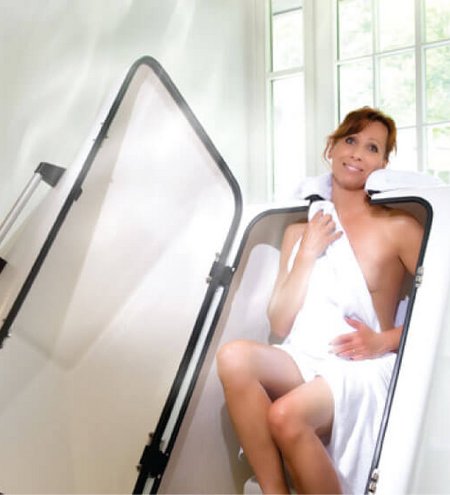Pain free back
Gastein cure
works for...
FAQ - Frequently asked questions & answers
How do I know that I suffer from Bekhterev's disease?
The causes of Bekhterev's disease are still largely unknown. Today, it is assumed that both hereditary predispositions and environmental influences trigger a pathological immune reaction of the body. And this ultimately manifests itself in the characteristics of Bekhterev's disease:
- Insidious onset
- Pain at rest in the lower back
- Nocturnal pain so severe that it wakes the patient in the middle of the night
- Stiffness in the morning, limited mobility of the lumbar spine
- Short-term improvement of pain with movement
Are there any scientific studies on the effect?
There are now numerous scientific studies on the effects of radon therapy or the Gastein cure.
Balneologists attribute anti-inflammatory and pain-relieving effects to the radioactive noble gas in low doses.
For many years, there has been very good proof of effectiveness in the form of randomised controlled studies, which were also carried out as placebo-controlled double-blind studies:
- The repair capacity of cells for damage to the genetic materialis improved by alpha radiation. Each cell is inherently capable of detecting and timely repairing dysfunctions up to malignant degenerations. If cells are initially exposed to low radiation, the otherwise usual damage of higher radiation doses does not occur.
- Radon or its secondary products accumulate in fat-rich tissues, especially in the adrenal cortex and the central nervous system. This could result in increased hormone production. Thus, the pain-relieving effect of a healing cave cure is attributed, among other things, to the release of endorphins (the body's own pain-relieving substances).
- The immune system is positively influenced: In patients with Bekhterev's disease and degenerative joint diseases, the initially reduced activity of defence cells has been normalised by radon therapy.
The production of radical scavengers is also increased. This means that free radicals (= destructive metabolic products), which also plays an important role in rheumatic processes, are rendered harmless.
How long does a spa treatment last?
Radon therapy relieves the pain of rheumatic diseases, which also includes Bekhterev's disease, for an average of 9 months. This is confirmed by the ImuRa study, among others.
Radon therapy – for which diseases is it effective?
In the course of almost a hundred years of documented experience with radon therapy and the now 65 years of experience with healing gallery therapy, a number of clinical pictures have crystallized for which radon therapy has proven to be specifically effective. These are:
- Illnesses of the rheumatic form circle, first of all the Bechterew's disease.
- Chronic polyarthritis/rheumatoid arthritis
- Arthrosis
- Certain forms of soft tissue rheumatism (fibromyalgia)
- Diseases of the respiratory tract, such as bronchial asthma or chronic bronchitis
- Skin diseases such as psoriasis, scleroderma and neurodermatitis
A complete overview of all medical indications for radon therapy can be found here.
Although radon cannot cure these chronic diseases, it can make a significant contribution to alleviating the symptoms. In order to improve the quality of life of the patients permanently, a regular repetition of the radon therapy may be indicated.
What forms of application are there for radon therapy?
Absorption via the skin and via the lungs: these are the two different forms of radon therapy as they are carried out today within the three- to four-week cures. In the case of baths in water containing radon, the noble gas enters the body mainly via the skin.
During a cure in the Healing Gallery, patients breathe in the radon-containing air and absorb it through the skin at the same time. The rising gases can also be intercepted and supplied to the patients via hoods for inhalation or in cabins as a vapour bath.
Radon therapy – who should be advised against it?
Medically, radon therapy is not recommended for:
- People with malignant or acute inflammatory diseases.
- People with hyperthyroidism
- Children up to 7 years of age
- Pregnant women
Cardiovascular diseases must also be clarified individually by a doctor.
You should not suffer from claustrophobia in the Healing Gallery.
Is radon therapy dangerous?
During a 3-week cure in a Healing Gallery, an average whole-body dose of approx. 1.8 mSv is to be expected. A value that corresponds approximately to the average annual exposure to radon in the natural environment of a Central European.
"Accordingly, radon therapy represents an exposure that is lost in the normal scattering" – according to the experts.
| The radiation dose in comparison | |
|---|---|
| Natural annual dose | 2.5 mSv |
| CT vortex column | 5 - 10 mSv |
| Spine X-ray, 2 steps | 2 mSv |
| 10 - 12 entrances into the healing tunnel | 1,8 - 2,2 mSv |
| Maximum permitted dose for employees according to radiation protection regulations | 20 mSv |
Further questions and details on radon therapy are answered in the brochure "10 Questions on Radon Therapy", compiled by the AG Europäischer Radonheilbäder, which is well worth reading.





























